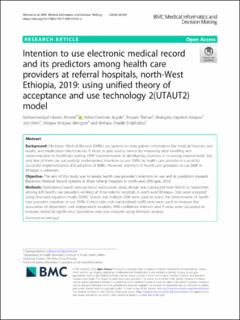| dc.contributor.author | Ahmed, Mohammedjud Hassen | |
| dc.contributor.author | Bogale, Adina Demissie | |
| dc.contributor.author | Tilahun, Binyam | |
| dc.contributor.author | Kalayou, Mulugeta Hayelom | |
| dc.contributor.author | Klein, Jörn | |
| dc.contributor.author | Mengiste, Shegaw Anagaw | |
| dc.contributor.author | Endehabtu, Berhanu Fikadie | |
| dc.date.accessioned | 2021-03-12T09:53:14Z | |
| dc.date.available | 2021-03-12T09:53:14Z | |
| dc.date.created | 2021-02-18T08:39:30Z | |
| dc.date.issued | 2020 | |
| dc.identifier.citation | Ahmed, M. H., Bogale, A. D., Tilahun, B., Kalayou, M. H., Klein, J., Mengiste, S. A., & Endehabtu, B. F. (2020). Intention to use electronic medical record and its predictors among health care providers at referral hospitals, north-West Ethiopia, 2019: using unified theory of acceptance and use technology 2 (UTAUT2) model. BMC Medical Informatics and Decision Making, 20(1), Artikkel 207. | en_US |
| dc.identifier.issn | 1472-6947 | |
| dc.identifier.uri | https://hdl.handle.net/11250/2733081 | |
| dc.description.abstract | Background: Electronic Medical Records (EMRs) are systems to store patient information like medical histories, test results, and medications electronically. It helps to give quality service by improving data handling and communication in healthcare setting. EMR implementation in developing countries is increasing exponentially. But, only few of them are successfully implemented. Intention to use EMRs by health care provider is crucial for successful implementation and adoption of EMRs. However, intention of health care providers to use EMR in Ethiopia is unknown. Objective: The aim of this study was to assess health care provider’s intention to use and its predictors towards Electronic Medical Record systems at three referral hospitals in north-west, Ethiopia, 2019. Methods: Institutional based cross-sectional explanatory study design was conducted from March to September among 420 health care providers working at three referral hospitals in north-west Ethiopia. Data were analyzed using structural equation model (SEM). Simple and multiple SEM were used to assess the determinants of health care providers intention to use EMRs. Critical ratio and standardized coefficients were used to measure the association of dependent and independent variables, 95% confidence intervals and P-value were calculated to evaluate statistical significance. Qualitative data was analyzed using thematic analysis. Result: The mean age of the study subjects was 32.4 years ±8.3 SD. More than two-third 293(69.8%) of the participants were male. Among 420 health care providers, only 167 (39.8%) were scored above the mean of intention to use EMRs. Factors positively associated with intention to use EMRs were performance expectancy (β = 0.39, p < 0.001), effort expectancy (β = 0.24,p < 0.001),social influence (β = 0.18,p < 0.001),facilitating condition (β = 0.23,p < 0.001), and computer literacy (β = 0.08,p < 0.001). Performance expectancy was highly associated with intention to use EMRs. Conclusion: Generally, about 40 % of health care providers were scored above the mean of intention to use EMRs. Performance expectancy played a major role in determining health care providers’ intention to use EMRs. The intention of health care providers to use EMRs was attributed by social influence, facilitating condition in the organization, effort expectancy, performance expectancy and computer literacy. Therefore, identifying necessary prerequisites before the actual implementation of EMRs will help to improve the implementation status. | en_US |
| dc.language.iso | eng | en_US |
| dc.rights | Navngivelse 4.0 Internasjonal | * |
| dc.rights.uri | http://creativecommons.org/licenses/by/4.0/deed.no | * |
| dc.title | Intention to use electronic medical record and its predictors among health care providers at referral hospitals, north-West Ethiopia, 2019: using unified theory of acceptance and use technology 2(UTAUT2) model | en_US |
| dc.type | Peer reviewed | en_US |
| dc.type | Journal article | en_US |
| dc.description.version | publishedVersion | en_US |
| dc.rights.holder | © The Author(s). | en_US |
| dc.source.volume | 20 | en_US |
| dc.source.journal | BMC Medical Informatics and Decision Making | en_US |
| dc.source.issue | 1 | |
| dc.identifier.doi | https://doi.org/10.1186/s12911-020-01222-x | |
| dc.identifier.cristin | 1891139 | |
| dc.source.articlenumber | 207 | |
| cristin.ispublished | true | |
| cristin.fulltext | original | |
| cristin.qualitycode | 1 | |

